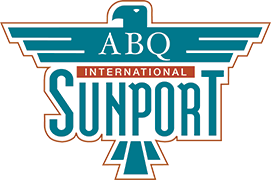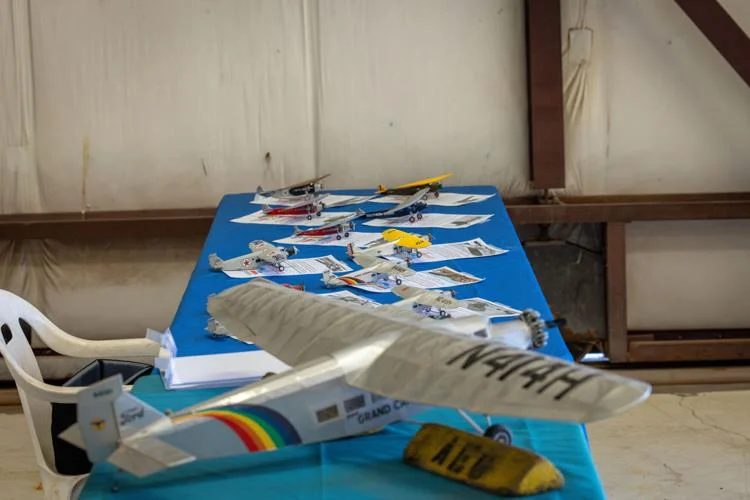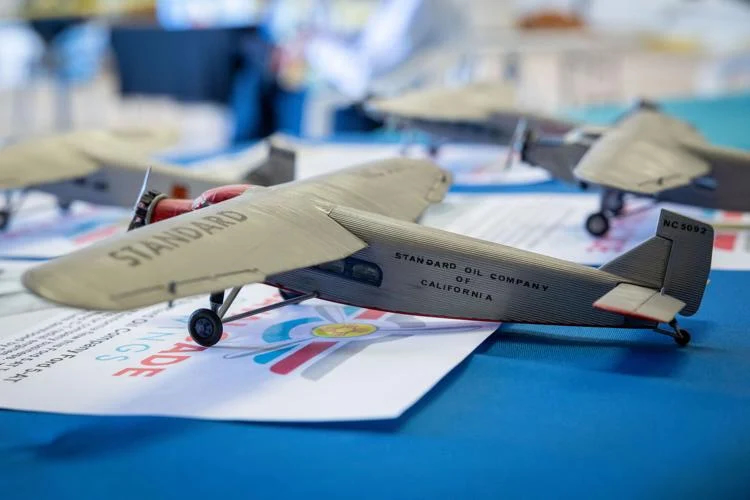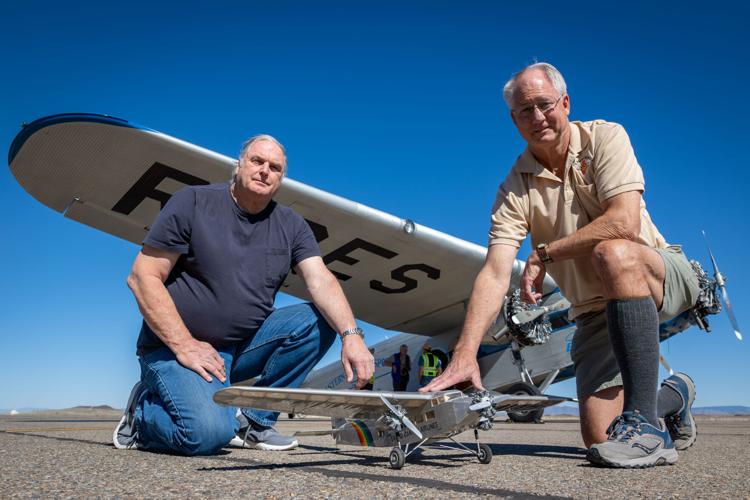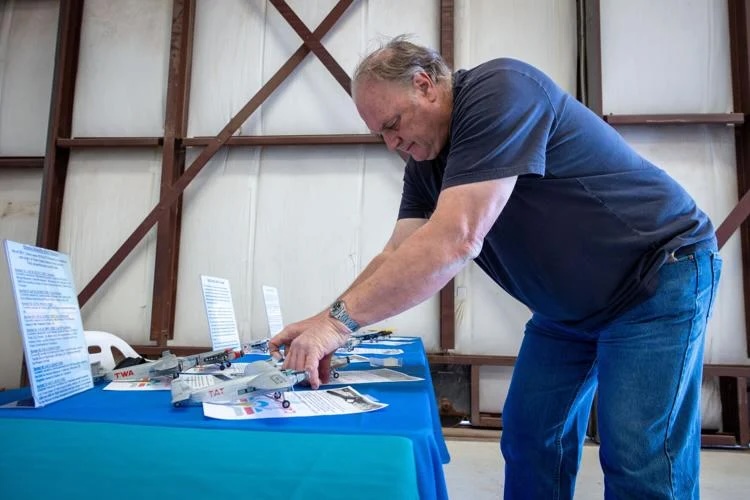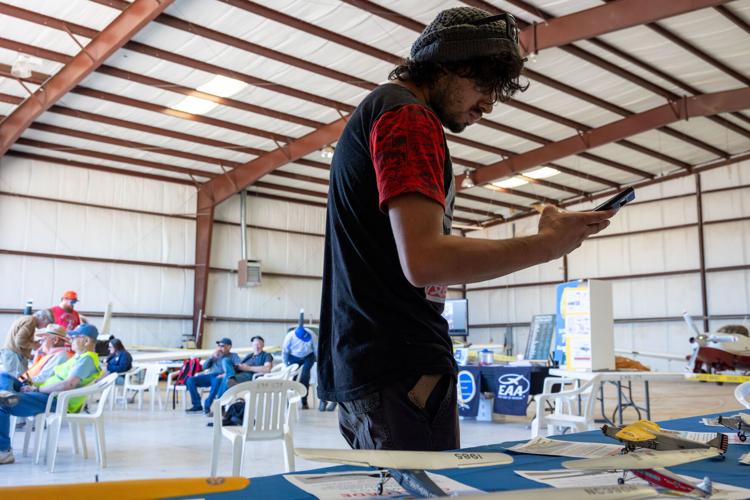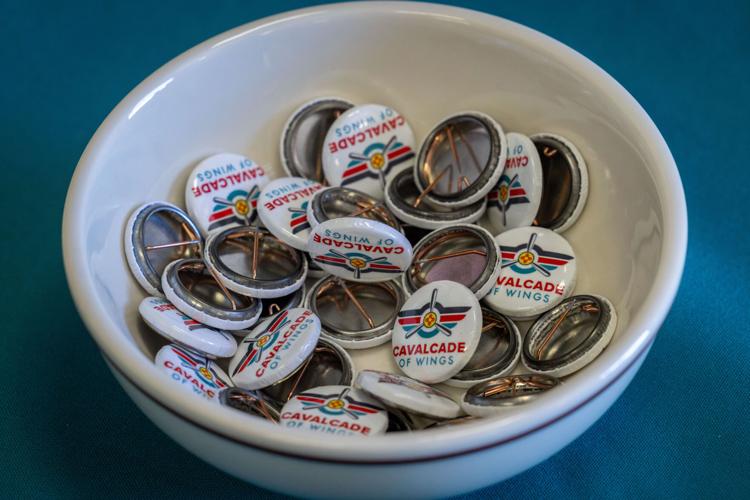History on the fly: Cavalcade of Wings dedicated to preserving and pursuing story of New Mexico aviation.
Photos by: Gino Gutierrez / Albuquerque Journal
By Ollie Reed Jr./ Journal Staff Writer Apr 4, 2024 Updated Apr 7, 2024
ALBUQUERQUE – Prop wash from the Ford Tri-Motor rumbling to life at Double Eagle II Airport blustered its way into the hangar, threatening to topple the model planes Michael Howell and Fred DeGuio were arranging on a table on a recent day.
Both men hovered protectively over scale models of seven Ford Tri-Motor aircraft and five Fokker Tri-Motors until the real tri-motor plane taxied away.
Howell is board chairman of Cavalcade of Wings, a nonprofit organization dedicated to documenting and displaying the aviation history of New Mexico, and DeGuio is one of Cavalcade’s board members. Their model exhibit detailed the history of Ford and Fokker tri-motor planes and the roles those planes played in New Mexico.
Both Fokker and Ford tri-motors flew into the state during the pioneer days of commercial air travel.
Fokker, a Dutch company, made about 250 tri-motor aircraft in two models, the F-7 and F-10, in the 1920s. Ford turned out 199 tri-motor planes in two variations, the 4-AT and the 5-AT, from the mid 1920s to the early 1930s.
“The Fokkers didn’t survive,” Howell, 67, says. “They had wooden components and were made out of cloth. There are zero Fokker Tri-Motors flying today.
“The Fords were made out of metal. The plane was nicknamed the Tin Goose. Being an all-metal plane makes a big difference. As of 2011, there were 18 Ford Tri-Motors in existence, and eight of them were flying. I don’t know how many are flying today.”
Well, the 1929 Ford 4-AT that came close to blowing the models away for one.
That plane, owned by the Experimental Aircraft Association, took paying passengers up for rides Thursday, Friday and Sunday at Double Eagle II on Albuquerque’s West Side.
Mission control
Cavalcade of Wings’ model and history display was on view in the Double Eagle II hangar during the Ford Tri-Motor rides, which were sponsored by Albuquerque EAA Chapter 179.
Howell and DeGuio, 66, selected the models for the hangar display from Cavalcade’s collection of about 900 models at the Albuquerque International Sunport. That collection, which consisted of just 34 models when first installed at the Sunport in 1965, was developed by Harry Davidson, who flew seaplanes and P2V Neptune patrol planes in the U.S. Navy.
Models in the Cavalcade’s collection were donated by airline companies, or were built and donated by members of the Albuquerque Scale Modelers club, Cavalcade board members, other aviation enthusiasts and pilots.
The collection emphasizes aviation in New Mexico from the first balloon flight in 1882 to commercial and military aircraft flying in the state today.
Howell refers to the Sunport collection, which also includes aviation insignia, photos and artifacts, as Albuquerque’s Aviation History Museum. It is located in display cases on the west side of the Sunport’s Great Hall, on the airport’s second level.
But Howell said plans are to relocate the collection to a more visible and accessible area in the Great Hall this year.
“During peak times, 6 million people walk through the Great Hall each year,” Howell said. “That fell off during COVID, but the numbers are coming back. However, if you don’t fly, you don’t know about Cavalcade of Wings. I want people to know there is a free aviation museum in Albuquerque.”
The Cavalcade collection is open to the public during Sunport hours, 24 hours a day, seven days a week. The only charge associated with visiting the collection is the Sunport parking fee.
Collection founder Davidson died in 2018. The 10-member Cavalcade board is dedicated to continuing and building on his mission as it accesses new information.
The organization’s website — cavalcadeofwings.com — is a work in progress, but includes information on Cavalcade’s plane models, Sunport history, Kirtland Air Force Base history, other airports and military bases in New Mexico and a lot more.
“When Harry Davidson started doing this, there was no internet,” Howell said. “We are making sure our information is accurate. We are improving the story, pulling out models that don’t apply to our narrative — aviation in New Mexico. One of our display cases will be designated as a rotating exhibit, so that the story will change on a regular basis.”
Early tragedies
DeGuio is the author of “Albuquerque International Sunport” (2019, Arcadia Publishing). In that book he writes that Albuquerque’s first airport opened in 1928, and that within a year Western Air Express and Transcontinental Air Transport (TAT) had established regular service to the city.
Famed aviator Charles Lindbergh, DeGuio notes, selected Albuquerque to be a stop on this country’s first commercial air route between Los Angeles and New York.
“I love Albuquerque’s transportation history,” Howell said. “We have the railroad, early aviation and Route 66. You couldn’t travel across America without stopping here.”
Not all of Albuquerque’s aviation history is glorious and glamorous.
One of commercial aviation’s earliest tragedies involved a Ford 5-AT Tri-Motor plane, named the City of San Francisco. The plane, operated by TAT, took off from Albuquerque on Sept. 3, 1929, en route to Winslow, Arizona, but got into bad weather and crashed on Mount Taylor, killing all eight persons on board.
The Associated Press reported that it was the first plane crash on a regular commercial land route.
Howell said a 1931 crash dealt a serious blow to the reputation and future of Fokker’s tri-motor planes. On March 31 of that year, the wing of a Fokker F-10 Tri-Motor broke apart in flight, and the plane crashed in a Kansas wheat field, killing famed Notre Dame football coach Knute Rockne and seven others.
Both Howell and DeGuio have aviation lineage.
Howell retired as a civilian facility engineer with the Air Force Research Labs at Kirtland. His father, who flew with an Air Force weather reconnaissance squadron, was stationed at Kirtland.
DeGuio’s father worked for Trans World Airlines, and DeGuio himself worked for American Airlines and Alaska Airlines in nonflying roles.
“I worked at everything from loading bags to airport operations agent,” DeGuio said. “But I am a pilot. I fly a Cessna 172.”
Howell is not a pilot.
“I get airsick,” he said. “I’m into the history.”
New blood
Cavalcade founder Davidson did not have the internet, but Howell said he was a prodigious letter writer.
“He wrote every airline, plane manufacturers, military personnel, and in the ‘60s and ‘70s they wrote back,” Howell said. “He had three letters from Lindbergh.”
Davidson also received letters from prominent aviatrix and racing pilot Jacqueline Cochran, British aviation pioneer Harold Blackburn, flamboyant barnstorming pilot Roscoe Turner and U.S. Army general and pilot Jimmy Doolittle.
Howell said the files Davidson assembled are so extensive, he is still working his way through them. He said he is looking for volunteers to help Cavalcade preserve and keep up with New Mexico’s flying history.
“We need new blood,” he said. “I want people who can write. I need people who don’t mind researching things, running things down.”
Pilot licenses not required.
